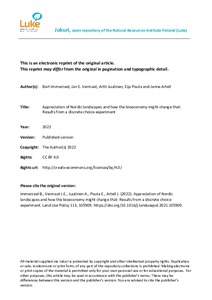Appreciation of Nordic landscapes and how the bioeconomy might change that: Results from a discrete choice experiment
Immerzeel, Bart; Vermaat, Jan E.; Juutinen, Artti; Pouta, Eija; Artell, Janne (2022)
Immerzeel, Bart
Vermaat, Jan E.
Juutinen, Artti
Pouta, Eija
Artell, Janne
Julkaisusarja
Land use policy
Volyymi
113
Sivut
13 p.
Butterworth Scientific
2022
Julkaisun pysyvä osoite on
http://urn.fi/URN:NBN:fi-fe2021121560644
http://urn.fi/URN:NBN:fi-fe2021121560644
Tiivistelmä
Surface waters and their catchments provide societal benefits through cultural ecosystem services like recreation and appreciation of nature. The supply of cultural services depends on landscape characteristics like the extent of forested area, water clarity and the intensity of land use. These attributes vary spatially and will likely be influenced by a possible transition to a bioeconomy, i.e. a shift towards more use of renewable, biological resources like forestry products. Using a discrete choice experiment, we quantified survey respondents’ preferences and willingness to pay for changing landscape attributes in six Nordic catchments and explored how different characteristics of both the landscape and respondents affect these preferences. Results from a mixed logit (MXL) model analysis show preference for a more equal distribution of agriculture and forest, improved water clarity, increased area used for nature reserves, reduced flood frequency and increased employment from agriculture, forestry and fishery. Variation in preferences between study areas is significant in several of these attributes, and likely linked to respondent characteristics. Since these attributes can be affected by the transition to a bioeconomy, policy makers should take into account the effects of this transition on the supply of cultural services by considering the effects on welfare generated by cultural services when implementing land management policy.
Collections
- Julkaisut [87133]
